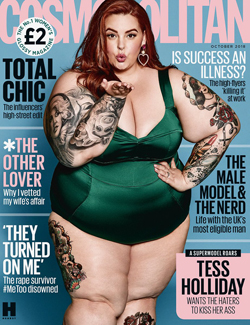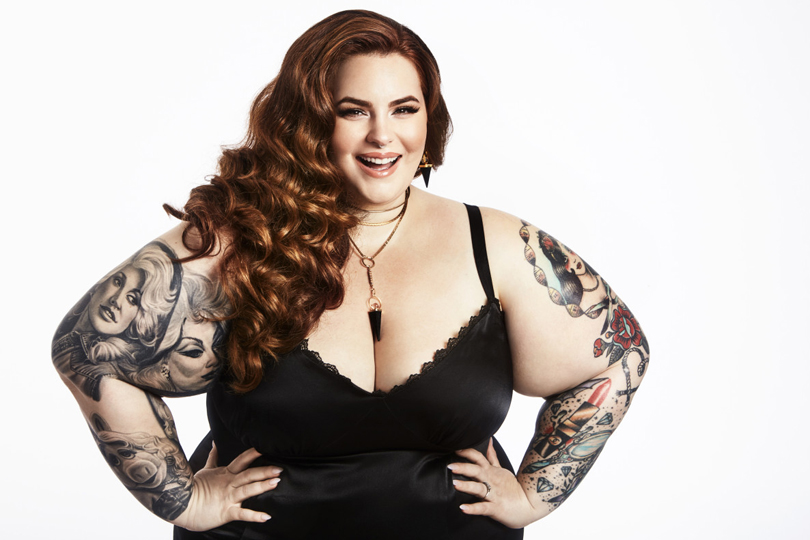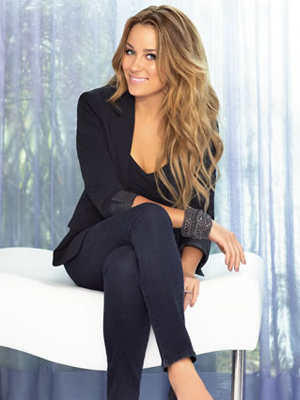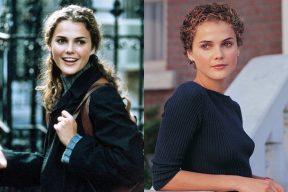A guide to leaving fat-phobia in the past, and living a more accepting life…
At the end of August, plus-size model, and body positivity activist Tess Holliday was announced as the October cover girl for Cosmo UK. This opened the metaphorical floodgates of personal opinion, otherwise known as Twitter dot com, for thousands of people to voice their disgust at seeing Holliday on the cover of a mainstream publication. The majority of trolls accused Holliday, and Cosmopolitan of promoting obesity. Others questioned Tess’s health, and why she was chosen for the front cover. Why is promoting obesity, and questioning health the first thing that comes to mind when we see someone who is larger than a size 14 thriving in the media? Why have we been conditioned to believe that one type of body is “healthy” and anything that’s bigger, or different is “unhealthy” even though we know nothing about that person’s actual health? We need to change the way we talk about plus size people in the media.
 In case you aren’t familiar with who Holliday is; Tess Holliday is a trailblazer for plus-size models. She is the first professionally signed plus-size model who is both 5’4, and a size 22. But why does this matter? It matters because as important a role that plus-size supermodels like Ashley Graham play in the BOPO and fashion diversity movement, they don’t have an average plus-size body. When plus size ladies look at models like Ashley Graham, they see a bombshell, and “body goals” but they often don’t see themselves. When a plus-size woman sees Tess Holliday on the cover of Cosmo, they see a body that looks like theirs, in a swimsuit, on the cover of a magazine. Tess Holliday has thick skin. She is on the BOPO front lines every day fighting back at trolls, haters, and people that question her health, her career, and her worth. She does it all with grace, and to be quite honest, she is constantly slaying. But imagine how exhausting it would be waking up every morning, and having to prove to the world that you deserve your success via Twitter, (which is not her job to do). So how do we start looking at plus-size people in the media? It’s quite simple actually. In fact, I’ve made a little guide for your reading pleasure.
In case you aren’t familiar with who Holliday is; Tess Holliday is a trailblazer for plus-size models. She is the first professionally signed plus-size model who is both 5’4, and a size 22. But why does this matter? It matters because as important a role that plus-size supermodels like Ashley Graham play in the BOPO and fashion diversity movement, they don’t have an average plus-size body. When plus size ladies look at models like Ashley Graham, they see a bombshell, and “body goals” but they often don’t see themselves. When a plus-size woman sees Tess Holliday on the cover of Cosmo, they see a body that looks like theirs, in a swimsuit, on the cover of a magazine. Tess Holliday has thick skin. She is on the BOPO front lines every day fighting back at trolls, haters, and people that question her health, her career, and her worth. She does it all with grace, and to be quite honest, she is constantly slaying. But imagine how exhausting it would be waking up every morning, and having to prove to the world that you deserve your success via Twitter, (which is not her job to do). So how do we start looking at plus-size people in the media? It’s quite simple actually. In fact, I’ve made a little guide for your reading pleasure.
First we all have to get on the same page of what the words “body positivity”, and the BOPO movement means. Contrary to popular belief, being body positive does not mean promoting obesity, and the ideology that bigger is better. Anybody, no matter what your shape or size is, can be body positive, because being body positive means waking up in the morning, and making a decision to love yourself, and be kind and gentle to yourself EVEN IF there are certain things you may want to change. Whether you’re a size 00 or 24, being body positive isn’t always easy. Some days it can be extremely difficult to set aside how much you hate the size of your arms, your thighs, your stomach. But this is your one shot, and body positivity is all about treating yourself with kindness. In fact, the whole body positivity movement actually boils down to one simple thing. Respect for both your own body, and the bodies of others.
Second, we have to stop commenting on people’s health you guys. We don’t know what underlying health issues somebody may, or may not have, period. If you are about to comment on a stranger’s health, first ask yourself how you would feel if somebody you didn’t know suggested you had a major health problem. The answer is probably no, and that’s because it literally none of your business. Tess Holliday was on the cover of Cosmopolitan. Not a health magazine, but a publication that focuses on female friendships, romantic relationships, fashion, and sex… all things that plus-size women actively participate in. Why aren’t these questions so easily asked with all other models on the covers of magazines? It all comes back around to respecting people for people. Plus-size people are so much more than their size. They have full lives, goals, dreams, and careers, just like everybody else.
Third, we have to be open to more representation in the media. Consider how important it is for somebody to see themselves on the cover of a magazine. We have only just started to scratch the surface of representation in popular media, and we have a lot more work to do. Seeing a different body type on the cover of a magazine shouldn’t make you uncomfortable, and if it does, you need to be asking yourself some questions. Fat-phobia is a word that Holliday uses a lot when she discusses how she is treated, and talked about in the media. Often times when plus-size models and influencers make great strides in mainstream media, it is unfortunately met with harsh criticism from people all over the internet that suddenly become experts on personal health. What ends up happening is that plus-size folks end up being de-humanized, constantly by being talked about as monsters that put a strain on national healthcare systems.
Everybody is human, everybody, and I mean every type of body is deserving of a basic level of respect. The reality is that we live in a society that punishes people for being different. I think the first step in being more accepting towards others is being kind to yourself. It’s like when you were being bullied in school, and your mom told you that the bullies are probably picking on you because they are unhappy with something in their own lives. When we are kinder to ourselves, we create more room in our lives to be happy for others. Simple, effective, and literally everybody wins.
When all is said and done, we need to celebrate people for their differences. We need to stop commenting on stranger’s health, and above all else, we need to be kinder to ourselves, and others. Body positivity is not promoting obesity, and plus-size people are not here to be diagnosed by strangers on the internet. Plus-size people are people, and they should be treated like people.











